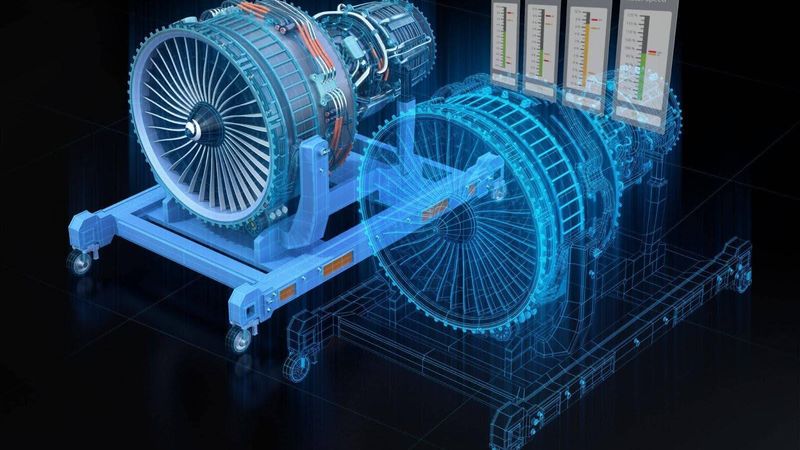Addressing Challenges in the Defense & Aerospace Industry with Digital Engineering Solutions
Defense & Aerospace companies are turning to digital engineering solutions to deliver advanced technologies while meeting strict timelines and budgets.
The rapid technological advancements present huge challenges to the Defense & Aerospace industry. As the demand for innovations rises, companies are under considerable strain to deliver advanced technologies while navigating strict timelines. Moreover, the increasing complexity of aerospace systems has made managing design, production, and operational challenges more critical than ever.
Companies adjust their procedures to ensure efficient and effective project execution for rising complexities and smooth system integration. Simultaneously, the industry is grappling with growing regulatory and cost pressures, as there is a heightened emphasis on reducing development times, to meet the rapidly evolving customer needs, while meeting defense and safety requirements. This balance between innovation and financial restrictions has become the industry's hallmark.
Challenges Faced by the Defense & Aerospace Industry
Defense & Aerospace programs often face the daunting task of delivering every more sophisticated systems at reduced cost and time. This demand to reduce costs and accelerate development cycles while maintaining the highest standards of quality and performance is a significant hurdle for companies operating in this sector.
In addition to these challenges, integrating new technologies into existing systems adds still another degree of difficulty. Companies have to incorporate these innovations while guaranteeing compatibility and best performance across all components.[1] This is further compounded by the need to manage and coordinate large, multi-functional teams, often spread across different locations and disciplines.
Moreover, legacy systems and outdated processes often hinder many organizations. These limitations can impede the adoption of modern digital engineering practices, which are crucial for staying competitive in today's fast-paced environment. Also, there is a growing need for real-time, accurate data throughout the product lifecycle, from design to operation, to enable data-driven decision-making and optimize performance.
Digital Solutions in Aerospace Engineering
To counter the challenges discussed above, Defense & Aerospace companies are increasingly turning to more integrated and digitalized product design and development solutions to. One such approach is implementing an integrated digital thread, which enable uninterrupted information flow throughout the concept, design, production, and operational stages. By creating a cohesive digital ecosystem, Defense & Aerospace companies can improve collaboration, optimize processes, reduce rework and maintain data consistency across the entire product lifecycle.
Model-Based Systems Engineering (MBSE)
Model-Based Systems Engineering (MBSE) is a powerful tool for managing the complexity of modern aerospace systems. By leveraging MBSE, engineers can create extended digital models that integrate various subsystems and components, allowing for efficient system design, simulation, and validation. This approach emphasizes using models as a central means of communication, analysis, and decision-making throughout the product lifecycle to detect potential issues early, reduce the need for physical prototypes, and facilitate better decision-making throughout development processes.[2] Additionally, MBSE facilitates collaboration among various stakeholders, assuring everyone works towards a shared understanding of the system's requirements and design.

Digital Twins
Digital twins—virtual replicas of physical systems are modifying how aerospace companies approach predictive analytics, optimization, and lifecycle management. By continuously collecting and analyzing data from sensors embedded in aircraft and other aerospace systems, digital twins provide real-time insights into system performance, facilitating proactive maintenance, improved efficiency, and heightened safety.[3] Digital twins also provide virtual testing and simulation, reducing the need for costly physical tests, hence accelerating the development approach.
Automation and Parametric Modelling
Using automation tools is also a crucial digital solution, such as parametric modeling, which is essential in speeding up the design processes and optimizing performance in the aerospace industry. By altering parameters, designers can quickly explore various design options without having to start from scratch each time. It enables rapid prototyping and iteration, leading to the identification of optimal solutions and reduced time to market.
Advanced Manufacturing and Supply Chain
The manufacturing sector is seeing a substantial transition with the use of Industry 4.0 technologies, including the Internet of Things (IIoT), big data analytics, and automation. These technologies facilitate the establishment of intelligent factories, wherein machines are outfitted with sensors that gather real-time data, thereby enabling communication between machines and between machines and humans. This data can be analyzed to predict and prevent equipment failures, optimize processes, and improve overall efficiency.
Augmented Reality (AR) is another key technology in Industry 4.0, bridging the gap between the physical and digital experiencs. AR enables technicians and engineers to access real-time information about complex machinery and equipment through wearable devices or mobile apps, thereby reducing the dependence on cumbersome manuals. The implementation of AR can significantly reduce installation and maintenance time, minimize errors and rework, and improve safety of the factory floor.
Quest Global is driving digital transformation in the manufacturing industry, providing solutions like Quest Global AR360. This platform helps companies develop, deploy, and manage AR applications for various industries, enabling them to reinvent training content, improve classroom experiences, and reduce dependency on field machines. By leveraging AR and other Industry 4.0 technologies, manufacturers can increase production, reduce costs, and improve overall efficiency, positioning for success in the era of smart manufacturing.
Cross-Industry Best Practices
Aerospace companies are also increasingly looking to adjacent industries, such as automotive and defense, to learn from their digital transformation experiences and adopt best practices to facilitate their digital journey.[4]
Case Study: Digital Engineering for UK Defense (Project Agnostics)
Quest Global is a leading global engineering services provider at the forefront of driving digital transformation in the Defense & Aerospace industry. One such example is Quest Global's collaboration with a leading aerospace and defense company to support the Future Combat Air System (FCAS) development for the UK Ministry of Defense (MoD). The FCAS program aimed to deliver a next-generation air defense system that would ensure the UK's air superiority for decades to come.
The FCAS project also faced several other key challenges, including tight timeframes, budget restrictions, and the inherent complexity of developing a state-of-the-art defense system at "half time and half cost." Additionally, integrating advanced digital engineering tools was important to ensure collaboration and efficient project execution.
Quest Global and its partner therefore created a digital engineering solution designed to address these challenges. It advanced the project by contributing as a thought leader and implementation catalyst. The team is collaborating with the customer to discover how digital technologies may improve procedures, lower costs, and speed up development.
To ensure the successful implementation of this digital engineering approach, Quest Global deployed a cross-functional team of 25 highly skilled engineers. This team combined expertise from across industries, including aerospace and defense, to create a robust and innovative digital engineering environment. The team significantly reduced project timelines and improved efficiency across the board by using advanced digital tools and best practices.
Quest Global's approach to digital engineering, which combines deep domain expertise with cross-industry best practices, is expected to be a key differentiator in the success of the FCAS project. The company's thought leadership and innovative solutions, tailored to the specific needs of the client, aim to deliver tangible results in terms of cost reduction and timeline acceleration.
By working towards the goal of reducing costs without compromising quality, Quest Global is demonstrating the potential of digital technologies to transform the aerospace industry. If successful, the substantial reduction in project development times could set a new standard for efficiency in the sector, paving the way for faster, more agile development processes in the future.
Conclusion: Future Directions for Aerospace Engineering
As the aerospace industry evolves, it is expected to increasingly adopt digital thread technologies, which enable easy integration and flow of data across the entire product lifecycle. The digital threads will be necessary for simplifying real-time monitoring, predictive maintenance, and enhanced lifecycle management of aerospace products. By using the digital threads, organizations can achieve improved efficiency, safety, and performance.
Looking ahead, the emphasis on cost and time reduction will remain a top priority for the aerospace industry, particularly in the defense sector.[5] Future projects will focus on delivering highly sophisticated systems within ever-tightening timeframes, driving the need for even more advanced digital engineering solutions and agile development methodologies.
The success of aerospace companies will be increasingly dependent on their capacity to acquire collaborative digital ecosystems. Organizations can accelerate decision-making, enhance innovation, and dismantle silos by establishing environments in which data circulates effectively across functions and teams. This shift towards increased collaboration and data-driven insights will be essential in addressing the numerous challenges faced by the aerospace industry.
New Webinar: Unlocking the Potential of Digital Twins for Aerospace Manufacturing
Register for Quest Global’s upcoming webinar “Unlocking the Potential of Digital Twins for Aerospace Manufacturing” on December 12th to learn more about how Quest Global provides digital engineering solutions to the aerospace industry, gain key insights, engage with industry experts, and ask questions.
References
1. Terrile RJ. Pathways and challenges to innovation in aerospace. In2010 IEEE Aerospace Conference 2010 Mar 6 (pp. 1-7). IEEE. (Accessed on September 20, 2024)
2. Uckun S, Kurtoglu T, Bunus P, Tumer I, Hoyle C, Musliner D. Model-based systems engineering for the design and development of complex aerospace systems. SAE Technical Paper; 2011 Oct 18. (Accessed on September 20, 2024)
3. Xiong M, Wang H. Digital twin applications in aviation industry: A review. The International Journal of Advanced Manufacturing Technology. 2022 Aug;121(9):5677-92. (Accessed on September 21, 2024)
4. Thompson R, Patel S. Cross-industry learning: Best practices from automotive to aerospace. J Eng Manag. 2022;35(3):245-60. (Accessed on September 23, 2024)
5. Patel, Jay. Future of Aerospace Industry with Opportunities and Challenges. 10.13140/RG.2.2.16721.51049. (Accessed on September 23, 2024)


